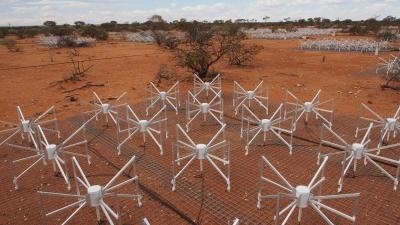Sun, Jul 14, 2013
Precursor To Planned Square Kilometer Array (SKA)
Australian officials say the world’s most sensitive radio telescope, the Square Kilometer Array (SKA), came a step closer to reality Monday with its first precursor telescope officially starting observations of the Universe.

The Murchison Widefield Array (MWA) (pictured) will explore the early Universe looking for signals from the first stars and galaxies, which formed after the Big Bang. It does this by collecting the very faintest radio signals from deep space using more than 2000 antennas. MWA is an important pathfinder project for the SKA, the world’s largest radio telescope which will operate in South Africa and Australia and will be 50 times more sensitive than any other radio instrument.
Australian Minister for Innovation Senator Kim Carr launched the MWA operational phase from Melbourne, Australia Monday. “This is an incredibly proud moment for Australia. The MWA is the first SKA precursor telescope to be completed and to become fully operational,” Senator Kim Carr said.
More than 350 astronomers and engineers from Australia, the United States, India and New Zealand have collaborated to make the project a reality.
“In addition to helping us see back to the origins of the universe, the array will also help us to understand the interaction between the earth and the sun, give early warning of destructive solar flares and study our galaxy and other galaxies,” Senator Kim Carr said. “I congratulate the international consortium, led by Prof Steven Tingay at Curtin University, whose hard work has delivered a world first for Australia.”
Director General of the international SKA Organization, Prof Philip Diamond, also welcomed the start of MWA science operations. “MWA is an important radio telescope in its own right. It will also be a key precursor in the design and development of the SKA’s Low Frequency Array, to be hosted in Australia.”
Senator Kim Carr said it showed how investment in one piece of Australian infrastructure could produce world class science outcomes in another. “Without the NBN link between Geraldton and Perth, the MWA would not have been possible,” Senator Kim Carr said. “The MWA will help Australia remain a world leader in radio astronomy while also building our scientific capabilities and attracting some of the best scientific minds to our country. Not only does radio astronomy make many marvellous discoveries about the universe, its development has produced technologies that we rely upon every day – like Wi-Fi. Australia is proud to be a partner in this global science project, and in the SKA.”
(Image provided by the Australian government.)
More News
“Honored to accept this mission. Time to take over space. Let’s launch.” Source: SecTrans Sean Duffy commenting after President Donald Trump appointed U.S. Secret>[...]
Permanent Echo Radar signals reflected from fixed objects on the earth's surface; e.g., buildings, towers, terrain. Permanent echoes are distinguished from “ground clutter&rd>[...]
Aero Linx: European Hang Gliding and Paragliding Union (EHPU) The general aim of the EHPU is to promote and protect hang gliding and paragliding in Europe. In order to achieve this>[...]
Glider Encountered A Loss Of Lift And There Was Not Sufficient Altitude To Reach The Airport Analysis: The flight instructor reported that while turning final, the glider encounter>[...]
Airplane Climbed To 100 Ft Above Ground Level, At Which Time The Airplane Experienced A Total Loss Of Engine Power On May 24, 2025, at 1300 eastern daylight time, an Aeronca 7AC, N>[...]
 Aero-News: Quote of the Day (07.11.25)
Aero-News: Quote of the Day (07.11.25) ANN's Daily Aero-Term (07.11.25): Permanent Echo
ANN's Daily Aero-Term (07.11.25): Permanent Echo ANN's Daily Aero-Linx (07.11.25)
ANN's Daily Aero-Linx (07.11.25) NTSB Final Report: Schweizer SGS 2-33A
NTSB Final Report: Schweizer SGS 2-33A NTSB Prelim: Aeronca 7AC
NTSB Prelim: Aeronca 7AC



